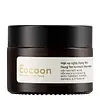What's inside
What's inside
 Key Ingredients
Key Ingredients

 Benefits
Benefits

 Concerns
Concerns

 Ingredients Side-by-side
Ingredients Side-by-side

Albumen
Skin ConditioningZea Mays Silk Extract
Skin ConditioningSilica
AbrasiveAllantoin
Skin ConditioningAloe Barbadensis Leaf Extract
EmollientPanthenol
Skin ConditioningLavandula Angustifolia Oil
MaskingPropolis Extract
Skin ConditioningParfum
MaskingBenzyl Benzoate
AntimicrobialWater
Skin ConditioningButylene Glycol
Humectant1,2-Hexanediol
Skin ConditioningNiacinamide
SmoothingCentella Asiatica Extract
CleansingRosa Centifolia Flower Extract
AstringentHippophae Rhamnoides Extract
MaskingBetula Alba Juice
AstringentAnastatica Hierochuntica Extract
AstringentAdenosine
Skin ConditioningCopper Tripeptide-1
Skin ConditioningGlycerin
HumectantSodium PCA
HumectantDisodium EDTA
Arnica Montana Flower Extract
MaskingEchinacea Angustifolia Extract
MoisturisingCommiphora Mukul Resin Extract
Skin ConditioningAlbumen, Zea Mays Silk Extract, Silica, Allantoin, Aloe Barbadensis Leaf Extract, Panthenol, Lavandula Angustifolia Oil, Propolis Extract, Parfum, Benzyl Benzoate, Water, Butylene Glycol, 1,2-Hexanediol, Niacinamide, Centella Asiatica Extract, Rosa Centifolia Flower Extract, Hippophae Rhamnoides Extract, Betula Alba Juice, Anastatica Hierochuntica Extract, Adenosine, Copper Tripeptide-1, Glycerin, Sodium PCA, Disodium EDTA, Arnica Montana Flower Extract, Echinacea Angustifolia Extract, Commiphora Mukul Resin Extract
Water
Skin ConditioningKaolin
AbrasiveSilica
AbrasiveCurcuma Longa Root Powder
Skin ConditioningCaprylic/Capric Triglyceride
MaskingHydroxyethyl Acrylate/Sodium Acryloyldimethyl Taurate Copolymer
Emulsion StabilisingTetrahydrodiferuloylmethane
AntioxidantCurcuma Longa Root Extract
MaskingNiacinamide
SmoothingLactic Acid
BufferingAvena Sativa Meal Extract
SoothingOryza Sativa Bran Oil
EmollientGlycerin
HumectantGlycereth-26
HumectantPhaseolus Radiatus Seed Extract
Skin ConditioningAllantoin
Skin ConditioningPropanediol
SolventButylene Glycol
HumectantJuglans Regia Shell Powder
AbrasiveXanthan Gum
EmulsifyingPentylene Glycol
Skin Conditioning1,2-Hexanediol
Skin ConditioningEthylhexylglycerin
Skin ConditioningTrisodium Ethylenediamine Disuccinate
BHT
AntioxidantMenthyl Lactate
MaskingPhenoxyethanol
PreservativeEucalyptus Globulus Leaf Oil
PerfumingSodium Benzoate
MaskingLavandula Angustifolia Flower Oil
MaskingChlorphenesin
AntimicrobialPotassium Sorbate
PreservativeWater, Kaolin, Silica, Curcuma Longa Root Powder, Caprylic/Capric Triglyceride, Hydroxyethyl Acrylate/Sodium Acryloyldimethyl Taurate Copolymer, Tetrahydrodiferuloylmethane, Curcuma Longa Root Extract, Niacinamide, Lactic Acid, Avena Sativa Meal Extract, Oryza Sativa Bran Oil, Glycerin, Glycereth-26, Phaseolus Radiatus Seed Extract, Allantoin, Propanediol, Butylene Glycol, Juglans Regia Shell Powder, Xanthan Gum, Pentylene Glycol, 1,2-Hexanediol, Ethylhexylglycerin, Trisodium Ethylenediamine Disuccinate, BHT, Menthyl Lactate, Phenoxyethanol, Eucalyptus Globulus Leaf Oil, Sodium Benzoate, Lavandula Angustifolia Flower Oil, Chlorphenesin, Potassium Sorbate
 Reviews
Reviews

Ingredients Explained
These ingredients are found in both products.
Ingredients higher up in an ingredient list are typically present in a larger amount.
1,2-Hexanediol is a synthetic liquid and another multi-functional powerhouse.
It is a:
- Humectant, drawing moisture into the skin
- Emollient, helping to soften skin
- Solvent, dispersing and stabilizing formulas
- Preservative booster, enhancing the antimicrobial activity of other preservatives
Allantoin is a soothing ingredient known for its protective and moisturizingg properties. Because of this, it is often added to products with strong active ingredients.
Studies show higher concentrations of this ingredient can promote wound healing.
Though it can be derived from the comfrey plant, allantoin is produced synthetically for cosmetic products to ensure purity.
Learn more about AllantoinButylene Glycol (or BG) is used within cosmetic products for a few different reasons:
Overall, Butylene Glycol is a safe and well-rounded ingredient that works well with other ingredients.
Though this ingredient works well with most skin types, some people with sensitive skin may experience a reaction such as allergic rashes, closed comedones, or itchiness.
Learn more about Butylene GlycolGlycerin is already naturally found in your skin. It helps moisturize and protect your skin.
A study from 2016 found glycerin to be more effective as a humectant than AHAs and hyaluronic acid.
As a humectant, it helps the skin stay hydrated by pulling moisture to your skin. The low molecular weight of glycerin allows it to pull moisture into the deeper layers of your skin.
Hydrated skin improves your skin barrier; Your skin barrier helps protect against irritants and bacteria.
Glycerin has also been found to have antimicrobial and antiviral properties. Due to these properties, glycerin is often used in wound and burn treatments.
In cosmetics, glycerin is usually derived from plants such as soybean or palm. However, it can also be sourced from animals, such as tallow or animal fat.
This ingredient is organic, colorless, odorless, and non-toxic.
Glycerin is the name for this ingredient in American English. British English uses Glycerol/Glycerine.
Learn more about GlycerinNiacinamide is a multitasking form of vitamin B3 that strengthens the skin barrier, reduces pores and dark spots, regulates oil, and improves signs of aging.
And the best part? It's gentle and well-tolerated by most skin types, including sensitive and reactive skin.
You might have heard of "niacin flush", or the reddening of skin that causes itchiness. Niacinamide has not been found to cause this.
In very rare cases, some individuals may not be able to tolerate niacinamide at all or experience an allergic reaction to it.
If you are experiencing flaking, irritation, and dryness with this ingredient, be sure to double check all your products as this ingredient can be found in all categories of skincare.
When incorporating niacinamide into your routine, look out for concentration amounts. Typically, 5% niacinamide provides benefits such as fading dark spots. However, if you have sensitive skin, it is better to begin with a smaller concentration.
When you apply niacinamide to your skin, your body converts it into nicotinamide adenine dinucleotide (NAD). NAD is an essential coenzyme that is already found in your cells as "fuel" and powers countless biological processes.
In your skin, NAD helps repair cell damage, produce new healthy cells, support collagen production, strengthen the skin barrier, and fight environmental stressors (like UV and pollution).
Our natural NAD levels start to decline with age, leading to slower skin repair, visible aging, and a weaker skin barrier. By providing your skin niacinamide, you're recharging your skin's NAD levels. This leads to stronger, healthier, and younger looking skin.
Another name for vitamin B3 is nicotinamide. This vitamin is water-soluble and our bodies don't store it. We obtain Vitamin B3 from either food or skincare. Meat, fish, wheat, yeast, and leafy greens contain vitamin B3.
The type of niacinamide used in skincare is synthetically created.
Learn more about NiacinamideSilica, also known as silicon dioxide, is a naturally occurring mineral. It is used as a fine, spherical, and porous powder in cosmetics.
Though it has exfoliant properties, the function of silica varies depending on the product.
The unique structure of silica enhances the spreadability and adds smoothness, making it a great texture enhancer.
It is also used as an active carrier, emulsifier, and mattifier due to its ability to absorb excess oil.
In some products, tiny microneedles called spicules are made from silica or hydrolyzed sponge. When you rub them in, they lightly polish away dead skin layers and enhance the penetration of active ingredients.
Learn more about SilicaWater. It's the most common cosmetic ingredient of all. You'll usually see it at the top of ingredient lists, meaning that it makes up the largest part of the product.
So why is it so popular? Water most often acts as a solvent - this means that it helps dissolve other ingredients into the formulation.
You'll also recognize water as that liquid we all need to stay alive. If you see this, drink a glass of water. Stay hydrated!
Learn more about Water